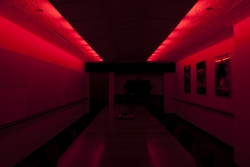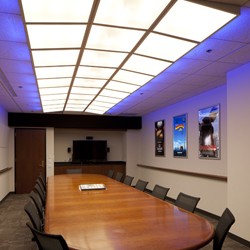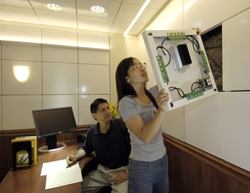Energy savings combined with high quality lighting and interchangeable, easily upgradable tiles present a plug-and-play system that is fully flexible and sustainable for many types of commercial, and possibly residential, uses. Future marketing of the LED grid infrastructure system will seek to capitalize on opportunities for both energy savings and customization of the system. The energy savings demonstrated with today’s technology (at 85 lm/W in 2012) is expected to more than double by the year 2020, when LEDs are expected to reach 200 lm/W efficacy. Because the lighted tiles are easily moved and replaced, new tiles can be purchased as more efficient models come to market. Custom looks also are achievable and expected to be a strong selling point. With a modular system such as this, there is an opportunity to develop tiles with a variety of looks and finishes to complement any interior design.”
LRC Demonstrates Advanced Building Infrastructure for Solid-State Lighting in Hollywood
From an LRC press release:
In a Hollywood conference room, researchers from the Lighting Research Center (LRC) at Rensselaer Polytechnic Institute and product engineers from Osram Sylvania capped off eight years of research and concept development with a field demonstration that takes LED lighting to the next level.
The first-of-its-type demonstration, installed at the offices of Paramount Pictures, features flexible, modular LED-lighted tiles on the ceiling and walls that can be moved to any location on a low voltage, DC-powered grid with wireless controls. Funded by a building energy research grant from the California Energy Commission, the project showcases a sustainable lighting system that can adapt to changing technology and space needs, as well as energy savings without sacrificing lighting quality.
From the LRC press release:
“Future Opportunities





